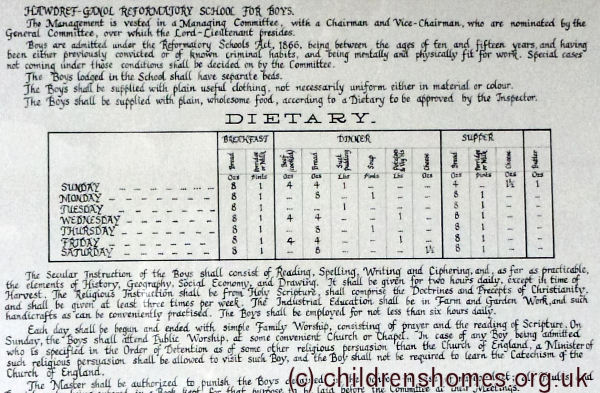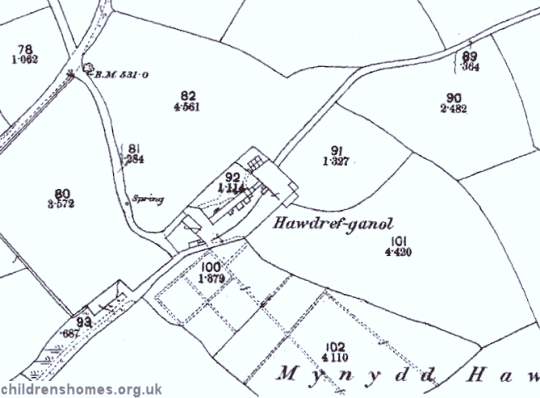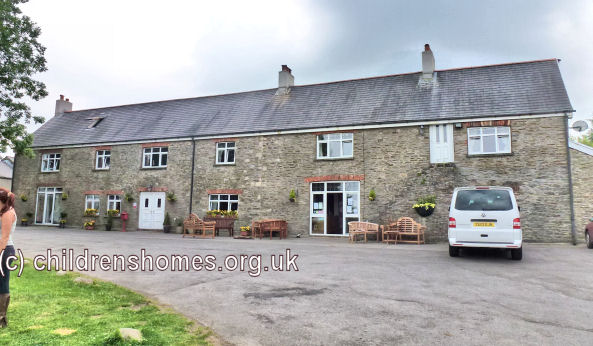Glamorgan Reformatory for Boys, Hawdref Ganol, near Neath, Glamorgan
The Glamorgan (or Glamorganshire) Reformatory School for Boys was certified to begin operation on March 4th, 1858. It was located in a farmhouse at Hawdref (or Howdref) Ganol, a few miles to the east of Neath. Although its official capacity was 50 inmates, an early inspection reports suggested that it could accommodate nearer 25 inmates. The property included nearly 250 acres of land, only part of which was cultivated, and was described as being in a "very wild and remote situation". Mr Bevan Smith, formerly at the Hardwicke Reformatory, near Gloucester, was appointed master, with his wife as matron.
With a large number of Irish families residing in the industrial towns of South Wales, the committal of Roman Catholic boys to the School led to some debate. Several applications had been made for the removal of such boys to the Catholic Reformatory at Market Weighton in Yorkshire. However, the distance of this institution and the expense and total separation from their parents, together with the positive refusal in some cases of the boys themselves to go, caused most of these applications to be withdrawn. It was suggested that the instruction of such inmates by a minister or teacher of their own persuasion might be a better solution.

Former Glamorgan Reformatory rules chart, Neath, 2013. © Peter Higginbotham
In 1860, a school-room, with dormitory over, was built, with Egbert Moxham as architect. A lavatory [washroom] was also fitted up, and the ground surrounding the School levelled and enclosed. After considerable delay, a schoolmaster was finally appointed. Around 80 acres of land were now under cultivation. Inspection reports regularly questioned the very large amount of land, most of it wild in character, that was rented by the Reformatory in relation to the number of inmates. The lack of livestock to produce manure was also criticised.
The location of the School site is shown on the 1878 map below.

Glamorgan Reformatory for Boys site, Hawdref Ganol, c.1878.

Former Glamorgan Reformatory for Boys from the west, Neath, 2013. © Peter Higginbotham
Mr Bevan Smith was replaced as master in 1861. The inspector noted that although he had considerable qualifications as a farm manager, he could do little as regards teaching and appeared to have been efficient in the economical management of the School. The new superintendent was Mr Goode, formerly schoolmaster and assistant at the Bradwall Reformatory. Mr Goode apparently did not take a liking to the establishment and in the autumn of 1862 departed to take charge of the Northampton Reformatory at Tiffield. His replacement remained just over a year then was succeeded in May, 1865, by Mr Farrah who had previously been at Castle Howard and Kingswood. Mrs Farrah acted as matron.
In 1868, it was noted that many of the boys at their time of admission scarcely understood English, which caused difficulties for their teaching. Four boys had deserted, said to be encouraged by the readiness with which they were sheltered and concealed. In an attempt to counter this, the School's managers prosecuted a small farmer who had harboured an absconder. A tailor now attended the School one day a week.
Under Mr Farrah's charge, the farming activity progressed considerably. By 1871, a flock of 120 sheep was being kept. The farmland, which had been reduced for some years, now extended to 350 acres of which 18 were arable.
In 1873, despite the improvement in the School's operation, its managers decided to relocate the establishment to a more accessible location. Accordingly, a 70-year lease was obtained on a farm of 42 acres, at Ty Segur on the outskirts of Neath. The move took place in the spring of 1875.
In recent times, the Hawdref Ganol site has been used as a guest house and outdoor activity centre.
Records
Note: many repositories impose a closure period of up to 100 years for records identifying individuals. Before travelling a long distance, always check that the records you want to consult will be available.
- The National Archives, Kew, Richmond, Surrey, TW9 4DU.
File MH 102/47 — contents described as a "general file" for the period 1858-1911.
Bibliography
- Carpenter, Mary Reformatory Schools, for the Children of the Perishing and Dangerous Classes, and for Juvenile Offenders (1851, General Books; various reprints available)
- Carlebach, Julius Caring for Children in Trouble (1970, Routledge & Kegan Paul)
- Higginbotham, Peter Children's Homes: A History of Institutional Care for Britain's Young (2017, Pen & Sword)
- Abel Smith, Doroth Crouchfield: A History of the Herts Training School 1857-1982 (2008, Able Publishing)
- Garnett, Emmeline Juvenile offenders in Victorian Lancashire: W J Garnnett and the Bleasdale Reformatory (2008, Regional Heritage Centre, Lancaster University)
- Hicks, J.D. The Yorkshire Catholic Reformatory, Market Weighton (1996, East Yorkshire Local History Society)
- Slocombe, Ivor Wiltshire Reformatory for Boys, Warminster, 1856-1924 (2005, Hobnob Press)
- Duckworth, J.S. The Hardwicke Reformatory School, Gloucestershire (in Transactions of the Bristol and Gloucestershire Archaeological Society, 1995, Vol. 113, 151-165)
Links
- Red Lodge Museum, Bristol — a former girls' reformatory.
Except where indicated, this page () © Peter Higginbotham. Contents may not be reproduced without permission.


